Reading trade books is an important component of an interdisciplinary approach to developing literacy skills and learning STEM content. This week we review recently published books that are strong choices for introducing STEM topics, initiating discussions and activities, and encouraging independent reading in the disciplines of science, technology, engineering, and mathematics.
Ages 4–8
Bird Builds a Nest (First Science Storybooks). Martin Jenkins. Ill. Richard Jones. 2018. Candlewick.
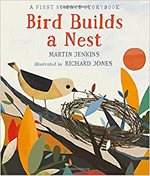 Birds are nature’s feathered engineers! With simple, straightforward text and beautiful mixed-media illustration, Jenkins and Jones give young readers a physics lesson on forces as Bird builds a nest. After successfully pulling up a juicy worm for breakfast, Bird lifts twigs of just the right size and pushes and pulls them in place to construct her nest, lines it with dried grasses and feathers, and molds it into shape with her body. A bonus “thinking about pushing and pulling” section with questions gets children thinking scientifically.
Birds are nature’s feathered engineers! With simple, straightforward text and beautiful mixed-media illustration, Jenkins and Jones give young readers a physics lesson on forces as Bird builds a nest. After successfully pulling up a juicy worm for breakfast, Bird lifts twigs of just the right size and pushes and pulls them in place to construct her nest, lines it with dried grasses and feathers, and molds it into shape with her body. A bonus “thinking about pushing and pulling” section with questions gets children thinking scientifically.
—JS
Face to Face with Wolves (Face to Face with Animals). Jim Brandenburg & Judy Brandenburg. 2018. National Geographic Society.
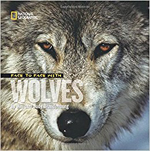 Once on the endangered species list, wolves have made a comeback in the United States. This book is filled with beautiful photographs (many of them close-ups) that invite the reader to come face-to-face with majestic wolves. After introducing readers to wolves and their activities, the authors describe the plight of the wolf from both historical and modern-day perspectives. Informational text features throughout the book include interesting captions, sidebars, and maps. Special features in the back matter include sections on how children can get involved and educational extensions for teachers.
Once on the endangered species list, wolves have made a comeback in the United States. This book is filled with beautiful photographs (many of them close-ups) that invite the reader to come face-to-face with majestic wolves. After introducing readers to wolves and their activities, the authors describe the plight of the wolf from both historical and modern-day perspectives. Informational text features throughout the book include interesting captions, sidebars, and maps. Special features in the back matter include sections on how children can get involved and educational extensions for teachers.
—JS
Flying Deep: Climb Inside Deep-Sea Submersible Alvin. Michelle Cusolito. Ill. Nicole Wong. 2018. Charlesbridge.
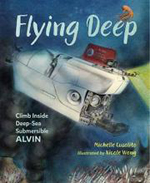 “Imagine you’re the pilot of Alvin, a deep-sea submersible barely big enough for three.” It’s an invitation for a dive almost two miles to the seafloor. An accessible text and digitally created illustrations give an hour-by-hour account of a dive: preparation for launch from the Woods Hole Oceanographic Institution’s research ship Atlantis; the two-hour descent beginning at 8:00 a.m.; survey of the site and collection of specimens from 10:00 a.m. to 3:00 p.m.; and ascent for a 5:00 p.m. end of the mission. Back matter includes an author’s note on the story behind Flying Deep, an illustrator’s note, Alvin facts, a glossary, notes on organisms encountered, and a “Learn More” section.
“Imagine you’re the pilot of Alvin, a deep-sea submersible barely big enough for three.” It’s an invitation for a dive almost two miles to the seafloor. An accessible text and digitally created illustrations give an hour-by-hour account of a dive: preparation for launch from the Woods Hole Oceanographic Institution’s research ship Atlantis; the two-hour descent beginning at 8:00 a.m.; survey of the site and collection of specimens from 10:00 a.m. to 3:00 p.m.; and ascent for a 5:00 p.m. end of the mission. Back matter includes an author’s note on the story behind Flying Deep, an illustrator’s note, Alvin facts, a glossary, notes on organisms encountered, and a “Learn More” section.
—CA
Hello Hello. Brendan Wenzel. 2018. Chronicle.
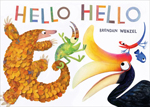 A “Hello Hello” greeting showing two cats, identical except for their colors (one white and one black), is followed by “Black and White” and a line-up of animals from the black cat on the left to a black-and-white striped fish on the right. The parade of animals continues, showcasing the diversity of their colors, shapes, patterns, habits, and more. “A world to see / A world to know.” An author’s note draws attention to getting to know more about the world’s animals and conservation efforts to save those in trouble. On the final four pages, the 92 featured animals are identified by common names along with a notation of their conservation status.
A “Hello Hello” greeting showing two cats, identical except for their colors (one white and one black), is followed by “Black and White” and a line-up of animals from the black cat on the left to a black-and-white striped fish on the right. The parade of animals continues, showcasing the diversity of their colors, shapes, patterns, habits, and more. “A world to see / A world to know.” An author’s note draws attention to getting to know more about the world’s animals and conservation efforts to save those in trouble. On the final four pages, the 92 featured animals are identified by common names along with a notation of their conservation status.
—CA
Hey-Ho, to Mars We’ll Go: A Space-Age Version of “The Farmer in the Dell.” Susan Lendroth. Ill. Bob Kolar. 2018. Charlesbridge.
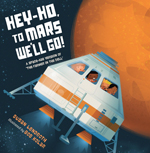 “THE ROCKET’S ON THE PAD. / The rocket’s on the pad. / Hey-ho, to Mars we’ll go— / The rocket’s on the pad.” Budding young astronauts will delight in this picture book about journeying to Mars that can be sung to the tune of “The Farmer in the Dell.” Each spread includes a four-line verse and one or more short paragraphs that provide readers with an account of what they could expect if they were astronauts travelling to Mars. The computer-generated, cartoonlike illustrations depict a diverse crew of young space explorers. An endnote provides information about Mars exploration and suggests three websites for further investigation.
“THE ROCKET’S ON THE PAD. / The rocket’s on the pad. / Hey-ho, to Mars we’ll go— / The rocket’s on the pad.” Budding young astronauts will delight in this picture book about journeying to Mars that can be sung to the tune of “The Farmer in the Dell.” Each spread includes a four-line verse and one or more short paragraphs that provide readers with an account of what they could expect if they were astronauts travelling to Mars. The computer-generated, cartoonlike illustrations depict a diverse crew of young space explorers. An endnote provides information about Mars exploration and suggests three websites for further investigation.
—JS
Kate, Who Tamed the Wind. Liz Garton Scanlon. Ill. Lee White. 2018. Schwartz & Wade/Random House.
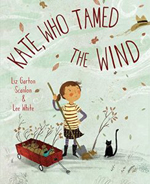 Eco-engineering is explored in this story about a man with a problem: His house sits at the top of a very windy hill, and the wind is wreaking havoc with his house and belongings. A clever young girl named Kate comes up with the idea of planting saplings that will grow to be a protective windbreak. As the trees grow over the years, Kate keeps coming back to visit the man and to see how her solution is working. An author’s note provides readers with more insight as to how trees help people and how people can help trees. The lyrical cumulative text and mixed-media illustration filled with windblown details make this picture book a good read-aloud choice.
Eco-engineering is explored in this story about a man with a problem: His house sits at the top of a very windy hill, and the wind is wreaking havoc with his house and belongings. A clever young girl named Kate comes up with the idea of planting saplings that will grow to be a protective windbreak. As the trees grow over the years, Kate keeps coming back to visit the man and to see how her solution is working. An author’s note provides readers with more insight as to how trees help people and how people can help trees. The lyrical cumulative text and mixed-media illustration filled with windblown details make this picture book a good read-aloud choice.
—JS
This Is the Nest That Robin Built. Denise Fleming. 2018. Beach Lane/Simon & Schuster.
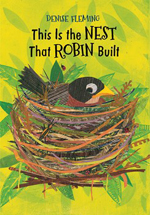 With spring approaching, it’s the perfect time to read Fleming’s picture book about the nest that Robin built—with help from some friends. A cumulative verse patterned after “This Is the House That Jack Built” and brightly colored, textured illustrations (created using print-making techniques combined with collage) relate the contributions of the friends to the nest building. A gatefold provides a step-by-step summary of Robin’s construction of the nest, in which she lays three eggs. The final pages show the young birds leaving the nest. “[N]ow young FLEDGINGS, / rumpled and ruffled, and ready to fly. / Good— / bye!”
With spring approaching, it’s the perfect time to read Fleming’s picture book about the nest that Robin built—with help from some friends. A cumulative verse patterned after “This Is the House That Jack Built” and brightly colored, textured illustrations (created using print-making techniques combined with collage) relate the contributions of the friends to the nest building. A gatefold provides a step-by-step summary of Robin’s construction of the nest, in which she lays three eggs. The final pages show the young birds leaving the nest. “[N]ow young FLEDGINGS, / rumpled and ruffled, and ready to fly. / Good— / bye!”
—CA
Ages 9–11
Curiosity: The Story of a Mars Rover. Makus Motum. 2018. Candlewick.
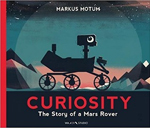 “Wherever you are in the world right now, I’m a very long way away. I’m not even on the same planet as you.” Beginning with these words, Mars rover Curiosity chronicles her personal journey from being designed and built at the Jet Propulsion Laboratory, near Los Angeles, California, to launch from the Kennedy Space Center, on the Florida coast, to safely landing on Mars in 2012 (after 253 days of traveling 13,000 miles per hour), to her continued exploration of Mars today. Curiosity ends her narration with speculations about the future of space exploration. Motum’s mixed-media illustrations in which he uses flat, geometric shapes in characterizing Curiosity, the expanses of outer space, and the Martian landscape have an intriguing retro look. Back matter includes information about other rovers that have now joined Curiosity on Mars, a timeline of Mars missions, and a glossary.
“Wherever you are in the world right now, I’m a very long way away. I’m not even on the same planet as you.” Beginning with these words, Mars rover Curiosity chronicles her personal journey from being designed and built at the Jet Propulsion Laboratory, near Los Angeles, California, to launch from the Kennedy Space Center, on the Florida coast, to safely landing on Mars in 2012 (after 253 days of traveling 13,000 miles per hour), to her continued exploration of Mars today. Curiosity ends her narration with speculations about the future of space exploration. Motum’s mixed-media illustrations in which he uses flat, geometric shapes in characterizing Curiosity, the expanses of outer space, and the Martian landscape have an intriguing retro look. Back matter includes information about other rovers that have now joined Curiosity on Mars, a timeline of Mars missions, and a glossary.
—CA
Ellie Engineer. Jackson Pearce. Ill. Tuesday Mourning. 2018. Bloomsbury.
 Third grader Ellie is an aspiring engineer. With her trusty toolbelt and design notebook always in hand, Ellie is the neighborhood go-to girl when problems need to be solved. When Ellie wants to design a doghouse for her friend Kit as a birthday present, Toby, one of the “yukky” neighborhood boys asks to help her, and she finds herself navigating the “girls-only/boys-only” mentality that has been causing friendship problems for her. Keeping secrets from Kit creates even more problems for Ellie. This middle-grade novel, complete with sketches from Ellie’s notebook and a guide to her favorite tools, includes themes of friendship, overcoming gender stereotypes, collaboration, and valuing everyone’s strengths.
Third grader Ellie is an aspiring engineer. With her trusty toolbelt and design notebook always in hand, Ellie is the neighborhood go-to girl when problems need to be solved. When Ellie wants to design a doghouse for her friend Kit as a birthday present, Toby, one of the “yukky” neighborhood boys asks to help her, and she finds herself navigating the “girls-only/boys-only” mentality that has been causing friendship problems for her. Keeping secrets from Kit creates even more problems for Ellie. This middle-grade novel, complete with sketches from Ellie’s notebook and a guide to her favorite tools, includes themes of friendship, overcoming gender stereotypes, collaboration, and valuing everyone’s strengths.
—JS
Who Says Women Can’t Be Computer Programmers?: The Story of Ada Lovelace. Tanya Lee Stone. 2018. Christy Ottaviano/Henry Holt.
 The informative text and witty gouache-and-india ink illustrations of this picture book biography provide an introduction to the life and accomplishments of Ada Byron Lovelace (1915–1952), who is recognized today as the first computer programmer. Fearing that she would grow up to have a wild imagination like her father, the famous poet Lord Byron, Ada’s mother set her on a course of study of math and science. Mastering these subjects, however, did not curb her imagination. When teenager Ada met scientist Charles Babbage, who demonstrated the model of his Difference Engine, a basic calculator, to her, “she was excited to realize that math and imagination did not have to be opposites.” Her later development of algorithms for Babbage’s proposed Analytical Engine was an important contribution to computer programming—even before there were computers. Back matter includes an author’s note, references, and sources of quotations.
The informative text and witty gouache-and-india ink illustrations of this picture book biography provide an introduction to the life and accomplishments of Ada Byron Lovelace (1915–1952), who is recognized today as the first computer programmer. Fearing that she would grow up to have a wild imagination like her father, the famous poet Lord Byron, Ada’s mother set her on a course of study of math and science. Mastering these subjects, however, did not curb her imagination. When teenager Ada met scientist Charles Babbage, who demonstrated the model of his Difference Engine, a basic calculator, to her, “she was excited to realize that math and imagination did not have to be opposites.” Her later development of algorithms for Babbage’s proposed Analytical Engine was an important contribution to computer programming—even before there were computers. Back matter includes an author’s note, references, and sources of quotations.
—CA
Ages 12–14
Drawn from Nature. Helen Ahpornsiri. 2018. Big Picture/Candlewick.
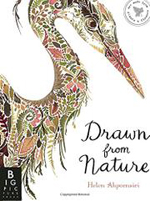 British artist Helen Ahpornsiri uses small, precise pieces of hand-pressed flowers, leaves, stems, and other plant parts to create delicate collage portraits of animals in their natural habitats that celebrate changes observed during the four seasons. For example, in the first section, Spring, topics include the predawn chorus of song heard during the mating season of songbirds, nest building, the budding of trees, the life cycles of butterflies and frogs, the hopping of hares in fields signaling the beginning of breeding season, and ducklings swimming in a row behind their mother. Each page includes several paragraphs of text describing this exploration of nature through the year. An author’s note, accompanied by a photograph of Ahpornsiri’s work space, helps readers understand how she creates her intricate artwork.
British artist Helen Ahpornsiri uses small, precise pieces of hand-pressed flowers, leaves, stems, and other plant parts to create delicate collage portraits of animals in their natural habitats that celebrate changes observed during the four seasons. For example, in the first section, Spring, topics include the predawn chorus of song heard during the mating season of songbirds, nest building, the budding of trees, the life cycles of butterflies and frogs, the hopping of hares in fields signaling the beginning of breeding season, and ducklings swimming in a row behind their mother. Each page includes several paragraphs of text describing this exploration of nature through the year. An author’s note, accompanied by a photograph of Ahpornsiri’s work space, helps readers understand how she creates her intricate artwork.
—CA
Wildflowers (Ultimate Explorer Field Guides). Libby Romero. 2018. National Geographic Society.
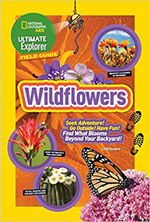 This new entry in the Ultimate Explorer Field Guide series is a compact, kid-friendly wildflower field guide for backyard adventurers and budding naturalists. Filled with full-color photographs, descriptions, facts, tips, tidbits, and even a few jokes, this handy guide, just right for the pocket or backpack, will help children spot and identify wildflowers in their backyard, neighborhood, and beyond. Back matter includes a photo-reference list organized by color, a glossary, and an index.
This new entry in the Ultimate Explorer Field Guide series is a compact, kid-friendly wildflower field guide for backyard adventurers and budding naturalists. Filled with full-color photographs, descriptions, facts, tips, tidbits, and even a few jokes, this handy guide, just right for the pocket or backpack, will help children spot and identify wildflowers in their backyard, neighborhood, and beyond. Back matter includes a photo-reference list organized by color, a glossary, and an index.
—JS
Ages 15+
Very, Very, Very Dreadful: The Influenza Pandemic of 1918. Albert Marrin. 2018. Knopf/Random House.
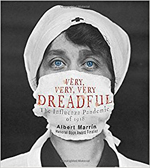 Albert Marrin presents an engaging history of influenza, focusing on the 1918 pandemic, the “most deadly disease event in the history of humanity.” He documents the overcrowded conditions of training camps, battlefronts, and hospitals during World War I and the lack of scientific understanding of the cause and ways of treating and controlling the spread of the disease that contributed to the three influenza waves—seasonal outbreak, epidemic, and pandemic. Marrin ends with present-day research, including the threat of the mutated H5N1 as a terrorist weapon and the inevitability of another influenza pandemic, the outcome of which will be “very, very, very dreadful” if we are not prepared to meet it. Back matter includes source notes, bibliography, picture credits, and index.
Albert Marrin presents an engaging history of influenza, focusing on the 1918 pandemic, the “most deadly disease event in the history of humanity.” He documents the overcrowded conditions of training camps, battlefronts, and hospitals during World War I and the lack of scientific understanding of the cause and ways of treating and controlling the spread of the disease that contributed to the three influenza waves—seasonal outbreak, epidemic, and pandemic. Marrin ends with present-day research, including the threat of the mutated H5N1 as a terrorist weapon and the inevitability of another influenza pandemic, the outcome of which will be “very, very, very dreadful” if we are not prepared to meet it. Back matter includes source notes, bibliography, picture credits, and index.
—CA
Jennifer W. Shettel is an associate professor at Millersville University, PA, where she teaches undergraduate and graduate course in literacy for pre-service and practicing teachers. Prior to joining the faculty at Millersville, she spent 16 years as an elementary classroom teacher and reading specialist in the public schools. Carolyn Angus is former director of the George G. Stone Center for Children's Books at Claremont Graduate University, Claremont, California.
These reviews are submitted by members of the International Literacy Association's Children's Literature and Reading Special Interest Group (CL/R SIG) and are published weekly on Literacy Daily.